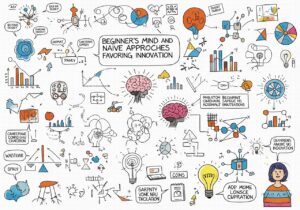Innovation often blooms in unexpected mindsets, as exemplified by George Dantzig’s remarkable experience with two statistics problems famously deemed unsolvable in his time. When Dantzig mistakenly submitted solutions to these “impossible” homework assignments, he unknowingly altered the trajectory of statistical research and later the simplex algorithm. This episode underscores a profound truth: our perceptions can shape the limits of our capabilities. A 2018 study found that individuals with a “beginner’s mind” approach are 25% more likely to achieve creative breakthroughs (Kahn & Gülşen, 2018).
By examining the psychological underpinnings of Dantzig’s success and the broader implications for innovation management, this article will elucidate how reframing challenges can dismantle self-imposed barriers and spark extraordinary solutions in engineering and product design.
A Retenir

- Deux célèbres problèmes de statistiques non résolus étaient des tâches erronées.
- George Dantzig les considérait simplement comme des tâches plus difficiles.
- Un état d'esprit dépourvu de limites peut conduire à des percées.
- Le point de vue d'un débutant peut inspirer des solutions innovantes.
- Surmonter les barrières mentales améliore les capacités de résolution de problèmes.
L'anecdote de George Dantzig

L'histoire
La rencontre de George Dantzig avec un problème apparemment impossible a commencé en 1939, alors qu'il était étudiant de troisième cycle à l'université de Californie, à Berkeley. Un soir, il arrive en retard en classe et croit à tort qu'on lui a assigné deux problèmes difficiles à résoudre à la maison. À son insu, ces problèmes étaient des défis non résolus de renommée mondiale dans le domaine des statistiques. Pour Dantzig, il s'agissait simplement d'une série d'exercices ordinaires à résoudre, ce qui l'a amené à se concentrer sur la recherche de solutions plutôt que de succomber à des limitations préconçues liées à leur difficulté.
Dantzig a travaillé assidûment sur ces problèmes pendant plusieurs jours, en appliquant ses connaissances en programmation linéaire. À la fin de son travail, il a soumis ses solutions, qui ont d'abord été considérées comme un simple devoir de fin d'études. Ce n'est que lorsque le professeur de Dantzig, Jerzy Neyman, s'est rendu compte de l'importance de ces "problèmes de devoirs" que le véritable poids de l'accomplissement de Dantzig a été reconnu.
Cette anecdote illustre une vérité profonde sur la cognition humaine : Dantzig a abordé le problème sans se soucier de son impossibilité. Son ignorance des défis à relever lui a permis d'utiliser un raisonnement créatif et une pensée stratégique, parallèlement aux éléments mis en évidence dans les théories psychologiques... et le génie des maths.
L'excellent film "Good Will Hunting"(1997) de Gus Van Sant, s'est inspiré de cette anecdote comme point de départ pour révéler les capacités de Will Hunting (Matt Damon).
[embedyt] https://www.youtube.com/watch?v=-ViPmcdlfbQ[/embedyt]
Conseil: lorsqu'ils sont confrontés à des défis, le maintien d'un état d'esprit exempt de limites peut donner lieu à des solutions inattendues. Encouragez les séances de remue-méninges en équipe où les participants sont invités à ignorer tout obstacle présupposé, ce qui favorise un environnement propice à la pensée innovante.
Les problèmes insolubles du 20e siècle

Le problème de Monty Hall présente un scénario dans lequel un candidat participe à un jeu télévisé et doit choisir l'une des trois portes. Derrière l'une de ces portes se trouve un prix de valeur, comme une voiture, et derrière les deux autres portes se trouvent des "chèvres" ou des non-prix. Une fois que le candidat a fait son choix, l'animateur, Monty Hall, qui connaît l'emplacement du prix, ouvre l'une des deux autres portes pour faire apparaître une chèvre. La question principale posée au candidat est alors la suivante : doit-il s'en tenir à son choix initial ou doit-il passer à l'autre porte qui n'a pas encore été ouverte ?
In the early 20th century, maths statistics faced numerous challenges, particularly with the conception of problems deemed unsolvable. Math focus was raising and statistics were were under-researched domains yet and compounded by a lack of advanced computing tools, limiting the ability to validate outcomes or engage in simulations that could clarify the inherent complexities of problems.
Une caractéristique importante de ces problèmes insolubles est qu'ils reposent sur la compréhension des limites associées à la théorie des probabilités et aux tests d'hypothèse.
On a non-pro level, cases like the famous “Monty Hall problem” showcased how intuition often led to incorrect assumptions:
Adopter l'esprit du débutant pour innover
Si l'on examine l'environnement des entreprises, on constate que les organisations qui favorisent une culture de l'expérimentation et de la prise de risque obtiennent souvent de meilleurs résultats que leurs concurrents. De telles cultures attirent les talents et nourrissent la pensée innovante.

- L'esprit du débutant et les approches naïves favorisent l'innovation en permettant d'aborder la résolution des problèmes sous un angle nouveau.
- Engineers often view challenges through established norms, which can limit creativity and innovation.
- Reconnaître la valeur de l'état d'esprit du débutant aide les individus à se détacher de leurs idées préconçues, ce qui facilite l'acquisition de nouvelles connaissances.
- Un état d'esprit libéré des limites perçues favorise la créativité et la résilience.
- Les organisations qui cultivent une culture de l'expérimentation et de la prise de risque tendent à surpasser leurs concurrents et à attirer les talents.
Conseil: En encourageant les équipes à aborder les défis comme des expériences plutôt que comme des problèmes, on peut débloquer des solutions innovantes sans les limites de la pensée traditionnelle.
Conseil: face à un défi, demandez-vous si les limites perçues sont universellement acceptées. Envisagez de réévaluer le problème sans avoir d'idées préconçues sur sa difficulté.
Conseil: encourager les séances de brainstorming où les participants sont invités à suggérer des idées "folles" sans pression de faisabilité. Cela peut conduire à des percées innovantes, car des suggestions apparemment irréalisables peuvent inspirer des solutions pratiques lorsqu'elles sont affinées. Cultiver une culture qui récompense l'innovation, quelle que soit sa source, peut conduire à des découvertes inattendues.
L'état d'esprit du débutant dans un contexte de résolution de problèmes :
| Critères | Approche traditionnelle | Approche de l'état d'esprit du débutant |
|---|---|---|
| Créativité | Limitée par les cadres existants | Encourage la libre pensée et l'exploration |
| Identification des problèmes | S'appuie sur des problèmes connus | Ouvert à la découverte de nouveaux défis |
| Génération de solutions | Améliorations progressives | Innovations radicales |
| Appétence pour le risque | L'aversion au risque | Disposé à expérimenter et à échouer |

Dépasser les limites que l'on s'impose : Les limites que l'on s'impose découlent souvent d'idées préconçues sur la faisabilité de certains problèmes. Cette barrière psychologique peut empêcher les équipes de tenter des solutions radicales. Une approche proactive consiste à cultiver un environnement qui encourage à poser des questions du type "et si...". La diversité des points de vue et des expertises peut révéler des aspects négligés d'un problème et inspirer des solutions innovantes. Notamment, des entreprises comme Google utilisent la méthodologie "20% time" ou "1 jour par semaine", permettant aux ingénieurs de consacrer une partie de leur semaine de travail à des projets parallèles.
Documenter les enseignements tirés : une évaluation systématique des projets antérieurs peut mettre en évidence des thèmes communs ou des modèles de réussite et d'échec dans la résolution des problèmes. En documentant les "leçons apprises", les organisations peuvent rompre les cycles d'inefficacité. Par exemple, les entreprises qui analysent le retour d'information des clients améliorent régulièrement leurs produits, en se concentrant sur les besoins des utilisateurs qui auraient pu être négligés auparavant. Ces pratiques de réflexion créent une boucle de rétroaction qui encourage l'amélioration continue et la flexibilité de l'approche, démantelant ainsi les obstacles à l'innovation que l'entreprise s'est elle-même imposés.
Conseil:intègrent des sessions de brainstorming structurées qui incitent les participants à envisager des solutions radicales, sans qu'aucune idée ne soit trop farfelue. La mise en place...
Vous avez lu 65% de l'article. Le reste est destiné à notre communauté. Vous êtes déjà membre ? Se connecter
(et aussi pour protéger notre contenu original contre les robots d'indexation)
Communauté mondiale de l'innovation
Se connecter ou s'inscrire (100% gratuit)
Voir la suite de cet article et tous les contenus et outils réservés aux membres.
Uniquement de vrais ingénieurs, fabricants, concepteurs et professionnels du marketing.
Pas de bot, pas de hater, pas de spammer.































Adopter un esprit de débutant, c'est plus facile à dire qu'à faire, surtout dans un monde d'entreprise sous haute pression ?
En effet, mais tout ce qui en vaut la peine n'est-il pas un défi ? Acceptez la pression et adaptez-vous !
Je n'ai jamais entendu parler de Dantzig de cette manière. innovation ?